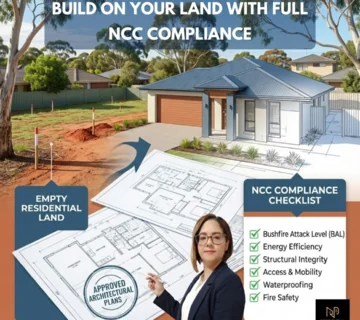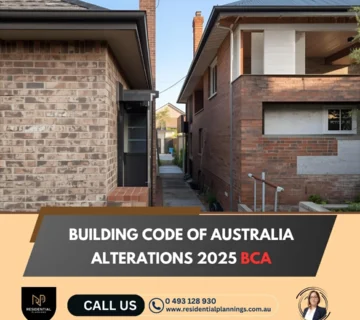Building Code of Australia 2025 (NCC 2025): Key Changes Every Designer and Builder Must Know
Australia’s building landscape is changing.
The Building Code of Australia 2025 (BCA 2025) — contained within the National Construction Code 2025 (NCC 2025) — introduces stricter energy, safety, and accessibility standards that affect both residential and commercial developments.
In this in-depth guide, Residential Plannings breaks down the most important NCC 2025 changes and what they mean for architects, builders, and homeowners.
⚡ 1. NCC 2025 Energy Efficiency and Electrification Reforms
The NCC 2025 energy efficiency chapter represents the biggest shift since 2019.
🔌 EV Charging Infrastructure NCC 2025
New residential developments may require dedicated circuits or pre-provisioning for electric vehicle (EV) chargers.
Apartment buildings and mixed-use complexes must integrate sufficient switchboard capacity and conduit access for future electrification.
🌡 Thermal Performance Upgrades
Enhanced insulation values and reduced U-values for glazing.
Thermal breaks in steel framing to minimise heat transfer.
Mandatory blower-door testing in some states to verify air-tightness.
☀️ NCC 2025 Solar PV Mandatory Provisions
Certain building classes (especially new residential and small commercial) will require on-site renewable generation, typically rooftop solar PV systems.
Designers must ensure roof orientation and structure accommodate future solar installations.
🔋 BCA 2025 Electrification Readiness
The BCA 2025 continues the national move away from gas:
Increased switchboard capacity for all-electric appliances.
Provisions for battery and future micro-grid connections.
Alignment with Australia’s 2050 net-zero trajectory.
🌫 2. Condensation Management & Vapour Control Enhancements
Building durability and indoor health are central to the NCC 2025 condensation management update.
🧱 Vapour Permeable Layers Australia
Walls and cladding systems must now include vapour-permeable membranes on the external side of insulation layers, especially in cool or mixed climates.
💨 Drained and Vented Cavities NCC 2025
Cavity walls require defined drainage paths and ventilation gaps to prevent trapped moisture.
These rules extend to balconies, podiums, and roof spaces, reducing mould risk and structural degradation.
💧 3. Waterproofing and Drainage Controls
The 2025 edition consolidates multiple past standards into unified water-shedding rules:
Stricter substrate slope tolerances for balconies and flat roofs.
Combined guidance for surface water, waterproofing, and cladding moisture control.
New detailing standards for junctions between balconies, podiums, and façades to eliminate internal ingress.
🔥 4. Fire Safety and Fire Resistance Adjustments
🚗 NCC 2025 Carpark Fire Safety & Car Stacker Fire Protection
With EVs introducing higher heat-release rates, carparks now face:
Sprinkler requirements for facilities with > 40 spaces or containing car stackers.
Removal of old concessions for open-deck carparks.
Higher fire-resistance levels (FRLs) for structural elements.
🧭 Improved Evacuation and Wayfinding
Expect clearer egress signage, stricter stairwell re-entry design, and more prescriptive smoke-control systems.
🧪 Performance Solutions Verification
Fire and structural performance alternatives must now include quantitative testing or modelling, not just expert opinion — improving reliability and accountability.
♿ 5. Accessibility & Alignment with Premises Standards AS 1428.1 (2021)
From 29 July 2025, the BCA updates its references to AS 1428.1 (2021), enforcing stronger universal-access provisions across public and mixed-use buildings.
Key NCC 2025 Accessibility Requirements
Wider doorways and continuous accessible paths.
Updated sanitary-facility dimensions and grab-rail reinforcement.
Enhanced signage and tactile ground indicators.
The intent is clear: build environments that are inclusive and future-proof.
🧾 6. Compliance and Verification Pathways
The BCA 2025 tightens documentation and testing obligations:
All performance solutions must be supported by verification methods — simulation, prototype testing, or equivalent evidence.
Builders must retain traceable records for audits.
Digital submission and certification platforms will be standardised across jurisdictions.
🕒 7. Timelines and Jurisdictional Adoption
Unlike past cycles, NCC 2025 adoption will roll out later than usual:
The public preview has been delayed beyond February 2025.
Formal commencement may occur in late 2025 or early 2026.
Until then, projects must comply with NCC 2022 (Amendments 1 & 2) unless a jurisdiction announces early adoption.
State adoption remains staggered:
NSW and VIC typically lead; WA, SA, and NT may introduce transition periods.
⚠️ Caveats and Key Takeaways
The BCA 2025 changes are draft proposals under final review.
Builders and certifiers should monitor state gazettes for adoption dates.
Early compliance design — particularly for energy, condensation, and fire safety — will minimise costly redesigns later.
🏗 Why This Matters for Design and Construction Professionals
The Building Code of Australia 2025 embodies Australia’s transition toward sustainable, resilient, and accessible buildings.
Architects, town planners, and certifiers must adapt workflows to:
Integrate EV and solar readiness.
Document vapour control and condensation strategy.
Specify fire-rated materials for car parks and mixed-use zones.
Provide universal access pathways and fixtures.
At Residential Plannings, we specialise in translating BCA updates into practical design and approval solutions for homeowners and developers.
Our planners and designers ensure your project meets NCC 2025 compliance without compromising aesthetics or budget.
👉 Visit Residential Plannings to learn how our team can future-proof your development.
💬 Frequently Asked Questions (FAQ)
1️⃣ When will the NCC 2025 take effect?
Final adoption is expected late 2025, with transition periods varying by state.
2️⃣ Is solar PV installation mandatory under BCA 2025?
Yes — for certain building classes and jurisdictions, NCC 2025 requires on-site renewables or renewable-ready infrastructure.
3️⃣ Do existing buildings need to comply with NCC 2025?
Only new work or additions must meet the current code; existing dwellings remain “grandfathered”.
4️⃣ What is AS 1428.1 (2021)?
It’s the updated Australian Standard for access and mobility, referenced in NCC 2025 to enhance accessibility and universal design.
5️⃣ How does NCC 2025 address fire risks from EVs and car stackers?
Through new sprinkler and FRL requirements for carparks with 40+ spaces and specific protection for mechanical stackers.




